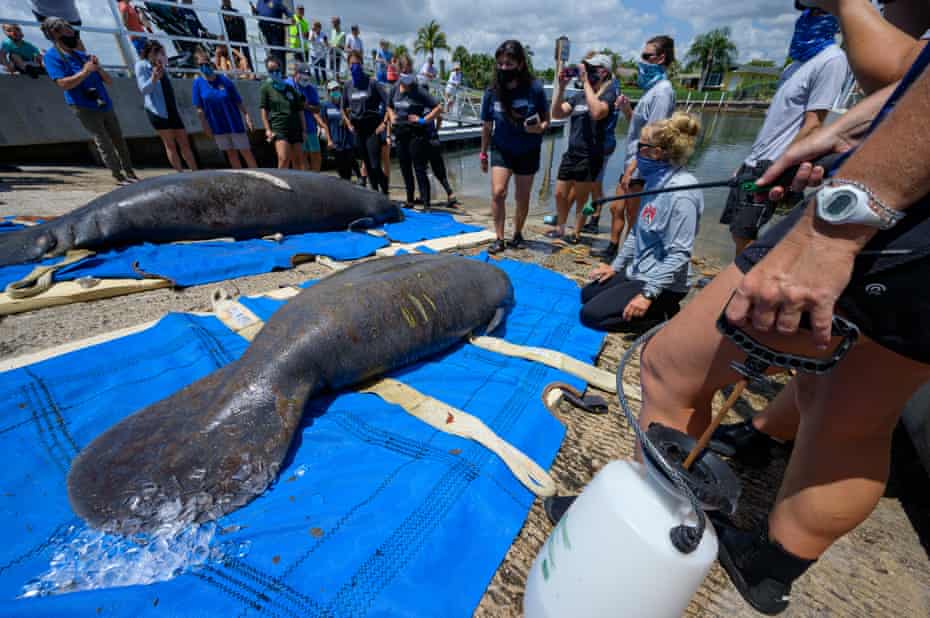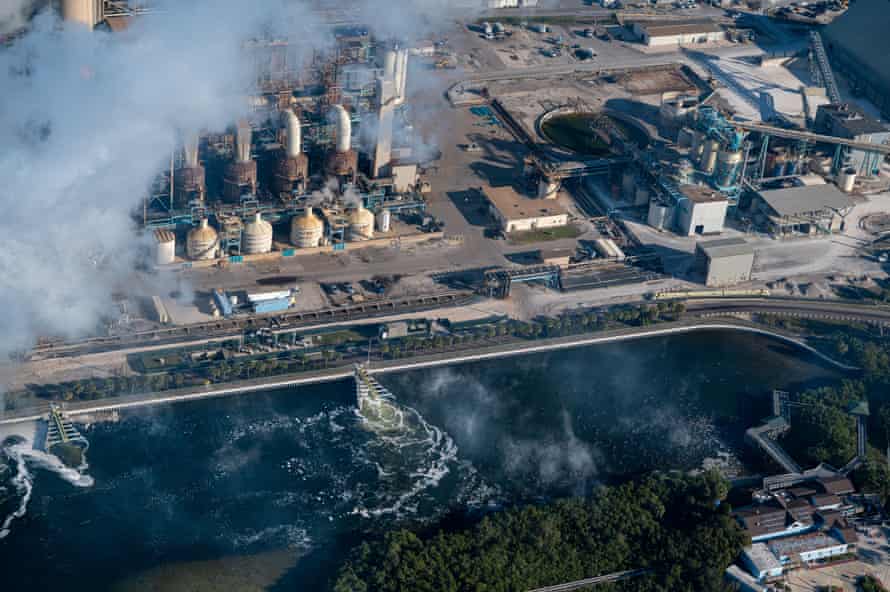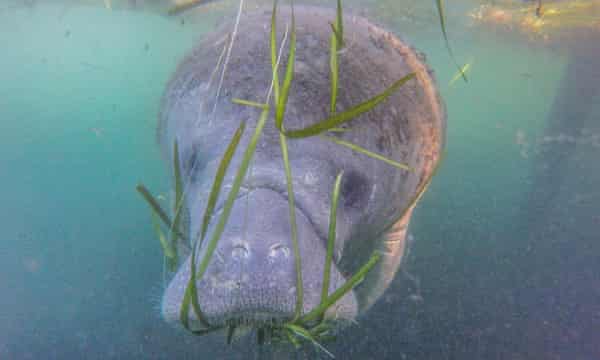Decimated by famine, Florida’s manatees face an uncertain future

2021 is already the deadliest year on record for Florida manatees. Scientists and activists are scrambling to avert further disaster
Last modified on Sat 31 Jul 2021 08.45 EDT
On a bright morning in July, a crowd gathered on a boat ramp in St Augustine, Florida, awaiting the arrival of a young male manatee named Gerard. The marshy Matanzas River gently flowed around oyster beds and sawgrass islands as biologists organized their equipment. Nearby about a dozen onlookers paced by the shore, waiting to catch a glimpse of Gerard’s return to the wild following weeks of captivity.
Earlier in spring, beachgoers discovered Gerard stranded and sunbaked in Palm Coast, about 25 miles south of St Augustine, on the Atlantic Ocean. Samaritans draped wet towels over the feeble marine mammal, keeping him cool and shaded from the subtropical sun, as a rescue team raced to the scene. Gravely thin, Gerard was transported to Jacksonville Zoo, where he spent the next 10 weeks in critical care until he was plump enough to re-enter the wild.
Gerard was one of the lucky ones.
Hundreds of Florida manatees have died this year along the state’s east coast in what the National Oceanic and Atmospheric Administration has labeled an “unusual mortality event”. At least 881 manatees have died in Florida since January, far exceeding the annual average of 578 deaths between 2015 and 2020.
Ground zero for the sudden uptick in deaths is the Indian River Lagoon, a 156-mile-long estuary that serves as a seasonal habitat for thousands of manatees. Decades of water pollution from farming and real estate development has pushed the ecosystem to the brink, causing the manatees to perish from an almost entirely manmade disaster: famine.
The current manatee crisis is “just a symptom of a system under extreme stress”, says Duane de Freese, executive director of the Indian River Lagoon Estuary Program, an agency that works to protect the waterway.
Now, scientists and activists are scrambling to avert further disaster.

A disturbing diagnosis
Last December, Martine de Wit puzzled over a troubling trend: manatees were dying at an alarming rate on the east coast of Florida. De Wit, a veterinarian who necropsies manatees for the Florida Fish and Wildlife Conservation Commission (FWC), attributed the deaths to stress caused by cold snaps that brought freezing temperatures to the Sunshine State. Despite their pudgy appearance, manatees lack blubber and are highly sensitive to cold. When temperatures drop below 68 degrees, they sometimes stop eating, begin to thin and crowd around in pockets of warm water.
But as temperatures rose in January, manatee deaths continued to climb. And by the first week of February, de Wit made a new diagnosis. Tissue samples taken from the gaunt carcasses delivered to her lab in St Petersburg showed atrophy in vital organs -telltale signs of starvation.
“They were severely emaciated,” de Wit said. Some were 40 percent below their expected body weight. The damage “was not something we have seen before on this scale in these large animals.”
By late April, after more than 696 manatees had died, federal officials stepped in to investigate and respond to the crisis.
During summer months, manatees venture as far north as New England for food. By winter, many manatees historically returned to the warm waters and abundant forage of Florida’s rivers, springsand coastal lagoons – habitats now frequented by people – following routes passed down over generations.
Some manatees still winter in these warm-water edens but thousands now find shelter in the tepid discharge of coastal power plants, including those in the Indian River Lagoon.
“When we put in power plants, we complicated the situation because we provided warm-water sources that aren’t necessarily in the best places [for manatees],” said Mike Walsh, co-director of aquatic animal health at the University of Florida’s College of Veterinary Medicine.

Generations of manatees have learned to return to these locations, Walsh said, where algal blooms and overgrazing have decimated seagrass coverage. Frigid temperatures can leave them trapped by invisible walls of cold water with next to nothing to eat. Malnourished manatees burn through vital body fat. Nursing calves drain their mothers dry. Some manatees survive the winter too weak to fully recover, and food supply is sparse for those who make it.
“Everything has been compromised,” Walsh said. “They don’t have enough to get by.”
Fields of seagrass suffocated by human development
Seagrass meadows once spanned nearly 80,000 acres in the Indian River Lagoon, where they serve as a cornerstone of one of the country’s most biodiverse estuaries. Their roots hold sediment in place, improving water quality and sequestering carbon.
These habitats suffered from coastal developments, which today expel some 2.5 million pounds of nitrogen and phosphorus into the estuary every year from septic tanks, lawns and farms. Meanwhile decades of organic matter has settled to the bottom as muck, a gooey substance that leaches nutrients into the water column.

“Basically all of the system has been declared impaired because the nutrient loads are too high,” said Charles Jacoby, an environmental scientist at the St John’s River water management district.
Combined nutrient loads can nourish intense algal blooms that block out sunlight and kill seagrass. A superbloom resembling pea soup in 2011 ushered in a devastating decade for the Indian River Lagoon. Nearly 46,000 acres of seagrass have disappeared as a result of these blooms.
In 2013, the Florida Department of Environmental Protection began a 15-year plan to address the damage in the Indian River Lagoon by dredging to remove muck, improving stormwater treatment and connecting homes that use leaky septic tanks to the sewer system.
“There’s no silver bullet unfortunately,” Jacoby said. “It’s going to take a lot of different efforts.”
Tour boats driving manatees from critical refuge
On the official emblem of Crystal River, a city on Florida’s Gulf Coast, there’s a banner reading “Home of the Manatee” that spirals around the image of a well-fed sea cow. The mammal is more than a mascot for the city – it’s an industry. Winter months bring hundreds of manatees to the warm, spring-fed waters of the Kings Bay Manatee Refuge. The only place in the country where people can legally swim with manatees, the refuge permits dozens of companies to offer tours to people eager for up-close encounters with the gentle giants.
On a sunny morning in June, Mike and Stacy Dunn boarded a pontoon boat for a trip around the bay. Only a few dozen manatees remain in Kings Bay this time of year, most of them nursing mothers and calves, so the Dunns take summer months off from the tour company they’ve operated for 12 years to avoid disturbing the sea cows and calves nursing in the canals. The Dunns know the bay better than most and volunteer as scouts for injured animals.

As the Dunns idled through the crystalline canals around Kings Bay, they passed fistfuls of slender seagrass uprooted by boat propellers or grazing marine life. These signs of abundance were all but absent a decade ago, when thick layers of muck and algae caked the bay. Manatees became so desperate for food, the Dunns watched them nearly sink a small island by munching on the foundation of roots to the serrated sawgrass.
Even the offseason brings crowds to Kings Bay, allowing some tours to operate year round. Nearby, a group of about ten people swam face down, buoyed by floating noodles and snorkels to the sky, as they approached a submerged sea cow. Swimmers are meant to practice “passive observance,” according to FWC guidelines, but the Dunns said not all tours enforce a no-contact policy.
For Pat Rose, executive director of the nonprofit Save the Manatee, Crystal River is both a model and cautionary tale for manatee conservation. Kings Bay is a critical refuge and the seagrass restoration project shows how resources can help improve manatee habitats. But the barrage of activity in the bay can distress the sea cows.
“It’s creating a lot of harassment and driving manatees out,” he said. As manatee populations rebounded, Florida failed to find more sanctuaries for the species. He worries the sea cows will always teeter on the edge of collapse without designated habitats.
A ‘bittersweet’ release, perhaps to face another famine
Gerard, the 600-pound rehabilitated manatee, arrived at the St Augustine boat ramp in the back of a box truck. In the bed of a nearby pickup, Monica Ross, a research scientist from the Clearwater Marine Aquarium Research Institute, prepared wildlife tracking equipment. For the next year, Ross and her team hope to monitor Gerard’s migration and feeding patterns using a satellite tracking tag that buoys behind the manatee like a fishing bobber and transmits his location.
By monitoring tagged manatees, Ross can document where they feed and how they use natural warm-water refuges. This data may guide protection plans for critical winter habitats. As energy production shifts away from fossil fuels, questions remain about how manatees will respond – and where they will go – when power plants, like those in the Indian River Lagoon, close down.
Seven people hauled Gerard out of the box truck on a blue stretcher and doused him with buckets of water. Having gained more than 100 pounds at Jacksonville Zoo, Gerard assumed the ovate shape of bread dough, formless but robust, the picture of fitness for a young sea cow. Once Ross tethered the tag to a belt around his tail, the team lowered the manatee into the turbid Matanzas River, where he disappeared beneath the surface save for the bobber trailing behind him.
The crowd cheered and shouted farewells, but for Ross the release was “bittersweet”. She worries Gerard will eventually head south to the Indian River Lagoon, where he’ll likely face another winter famine.
“Normally, when you release an animal, you’re very happy,” she said. “But we’re very concerned about what he’s going to have to deal with this winter.”
.png)